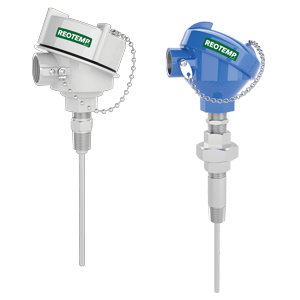Making Sense of RTD Tolerance Classes
 Today’s RTD tolerance classes grew out of the practical need to be able to install and replace probes and have them work the same from probe to probe. True plug and play.
Today’s RTD tolerance classes grew out of the practical need to be able to install and replace probes and have them work the same from probe to probe. True plug and play.
Many different RTD standards have been developed over the years and around the globe: SAMA, GOST, OIML, BS, JIS, DIN, ASTM, IEC etc. Many of these specifications share identical class names, but not always identical tolerance values. It’s a confusing landscape to navigate, so let’s dig deeper and make sense of it.
Key Takeaways
- “Percentage accuracy” is at 0 °C only and reflects resistance, not temperature
- Error increases with temperature
- Class B fits most industrial needs, Class A suits sanitary
- Validity ranges vary by manufacturer
- Reotemp Hi-Accuracy with Callendar–Van Dusen coefficients can improve accuracy by ≈5×
The Myth of “Percentage” Accuracy
One of the most misunderstood aspects of RTD tolerance is the percentage value often used to describe accuracy.
This shorthand came from the way platinum resistors were originally grouped into tolerance classes, much like common electronic resistors (20%, 10%, 5%, etc.). Over time, that shorthand carried into the world of industrial RTDs.
But here’s the catch:
- These percentage ratings only apply at 0 °C.
- They describe resistance tolerance, not direct temperature accuracy.
So when you see a Class B RTD listed at 0.12%, it does not mean ±0.12 °C. Instead:
- A 100 Ω RTD at 0 °C = 100 Ω ± 0.12 Ω.
- A 1000 Ω RTD at 0 °C = 1000 Ω ± 1.2 Ω.
When converted back to temperature, both equal ±0.3 °C, and only at 0 °C.
These percentage ratings understandably cause confusion. In addition, unlike a pressure gauge where a percentage tolerance is fixed over the entire span of the gauge, an RTD’s tolerance varies with temperature.
So, while the percentage can be helpful to quickly gauge an element’s accuracy, it’s not particularly helpful if you need to measure higher or lower temperatures.
IEC 60751: The Gold Standard
In order to determine the actual temperature tolerance of an RTD element, we need to look beyond the shorthand percentage value. The actual specifications include equations that can be used to calculate temperature tolerance values across the entire working range of the RTD element. IEC 60751 is the most widely accepted international standard for RTDs, and includes the following tolerance classes for industrial RTD thermometers.
| Tolerance Class | Temperature Range of Validity | Tolerance |
|---|---|---|
| AA | 0 / 150°C | +/- (0.1 + 0.0017 * | T |) °C |
| A | -30 / 300°C | +/- (0.15 + 0.002 * | T |) °C |
| B | -50 / 500°C | +/- (0.3 + 0.005 * | T |) °C |
To calculate the allowable tolerance for a given temperature, plug the absolute value of the temperature in °C into the T.
So, for both 50°C or -50°C, the formula for a Class B tolerance would be:
+/- (0.3 + 0.005 * (50)) °C = +/- 0.55°C.
The standard allows for manufacturers to have tolerances and temperature ranges of validity that differ from those in the standard. For example, all Reotemp RTDs will hold at least a Class B tolerance across the entire operating range of -200 / 600°C. Class AA and Class A RTDs will hold their tighter tolerance within the “temperature range of validity”, and then fall back to a Class B tolerance beyond that range. This is manufacturer specific, and not part of the standard. The following table illustrates the difference between these tolerance classes for Reotemp RTDs.
| Temperature °C | Class AA RTD °C | Class A RTD °C | Class B RTD °C |
|---|---|---|---|
| -190 | 1.25 | 1.25 | 1.25 |
| -100 | 0.80 | 0.80 | 0.80 |
| -50 | 0.55 | 0.55 | 0.55 |
| 0 | 0.10 | 0.15 | 0.30 |
| 50 | 0.19 | 0.25 | 0.55 |
| 100 | 0.27 | 0.35 | 0.80 |
| 200 | 1.30 | 0.55 | 1.30 |
| 300 | 1.80 | 0.75 | 1.80 |
| 500 | 2.80 | 2.80 | 2.80 |
| 600 | 3.30 | 3.30 | 3.30 |
A few key takeaways:
- Class B is the workhorse for most industrial applications.
- Class A is often preferred in sanitary processes (and is the standard for our Sanitary RTD product line).
- Special classes (like 1/10 B or 1/5 B) aren’t in IEC 60751, but are used in industry for tighter control around one specific temperature as they have extremely narrow temperature ranges of validity.
Going Beyond the Standard
So, how can you achieve higher accuracy across the entire operating range? In order to do this, we need to leave behind class definitions which apply to general groups of RTD sensors and focus instead on individual RTD elements.
The Reotemp “AC” or “High Accuracy” option refers to this practice. By performing an intensive calibration with high end metrology level equipment on an individual probe, we can determine a probe’s unique relationship between resistance and temperature. This relationship can be mapped with several constants that are specific to each RTD element.
IEC 60751 provides a general equation for all RTD sensors to relate their resistance reading to temperature. All RTDs with the same alpha coefficient (.00385 Ω/(Ω·°C for most industrial RTDs) utilize this general equation to calculate the temperature of the element. Temperature transmitters, indicators, meters and other industrial equipment are usually preprogrammed with this general curve so that when the element is connected, you see the value in temperature units rather than resistance.
Think of it like a 7 lane highway:
- Class B RTDs can wander in any lane.
- Class A RTDs stick closer to the center lanes.
- Class AA RTDs stay even tighter.
- With a Reotemp Hi-Accuracy AC calibrated RTD, we know exactly which lane the probe is in, all the time.
The coefficients that map the individual RTD’s journey along the highway are referred to as Callendar Van Dusen coefficients.
FAQ
- What do Class AA, A, and B mean?
- They are IEC 60751 tolerance classes with equations that define allowable error over temperature. Class AA is tighter than Class A, which is tighter than Class B, each within its stated validity range.
- Does percentage accuracy equal temperature accuracy?
- No. The percentage applies at 0 °C and describes resistance tolerance. Temperature accuracy across the range comes from the IEC 60751 formulas.
- Which tolerance class should I choose?
- Class B suits most industrial applications. Class A is common in sanitary service. Fractional classes such as 1/10 B target narrow ranges around a single point. Always verify the stated validity range.
- What is Callendar–Van Dusen?
- It is the equation and set of coefficients that map an RTD’s resistance to temperature. Loading probe specific CVD coefficients into a transmitter lets it calculate temperature more accurately across the operating range.
- Do tolerances hold outside the validity range?
- Manufacturers may specify behavior beyond the range. Class AA and Class A often revert to Class B tolerance outside their ranges, and many elements maintain at least Class B across a wider span.
